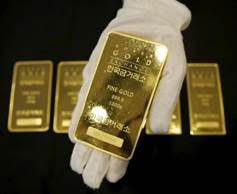June Payrolls And Gold Price

The US economy added 222,000 jobs in June. What does it mean for the gold market?
Job Gains Strong In June
Total nonfarm payroll employment increased 222,000 in June, following an increase of 152,000 in May (after an upward revision), according to the U.S. Bureau of Labor Statistics. Analysts had expected 170,000 jobs created. Thus, the actual number was significantly above expectations. Moreover, employment gains in April and May combined were 47,000 higher than previously reported. It’s a huge upward revision. It means that job gains in the last three months have averaged 194,000, a big jump from 121,000 seen in the previous month.
The job gains were widespread. The more jobs were again created in education and health services (+45,000), in leisure and hospitality (+36,000), and in professional and business services (+35,000). But this time government added 35,000 jobs (contrary to cuts in May). Moreover, financial activities, construction, trade and mining hired many workers as well. Hence, job gains were strong in June. They were actually the largest in four months and the second biggest haul of the year. Nevertheless, the annual job growth rate remains in a downward trend, despite the recent rebound, as the chart below shows.
Chart 1: Total nonfarm payrolls (percent change from year ago) over the last five years.
However, the recent job gains may strengthen the hawkish camp at the U.S. central bank and give the Fed reason to continue its monetary tightening. Indeed, the market odds of an upward move in December increased slightly after the release of the employment situation report. The Friday’s payrolls will not, of course, accelerate the pace of tightening, but they may dissolve some doubts about the Fed’s current path of actions.
Other Labor Market Indicators
Other labor market indicatiors were slightly positive, on balance. Although the unemployment rate rose from 4.3 percent to 4.4 percent, it remained at a very low level. The average hourly earnings for all employees on private nonfarm payrolls rose by 4 cents to $26.25. It means that the hourly pay jumped 2.5 percent over the year, which might be a bit disappointing, but it’s definitely far from disaster. Moreover, the labor force participation and the employment-population rate were slightly changed, while the average workweek rose 0.1 hour to 34.5 hours.
Payrolls, Fed And Gold
In our opinion, the June report was strong, which is a positive surprise after a disappointing ADP report released on Thursday, which showed that private-sector hiring slowed in June. Hence, it should be negative for gold. And indeed it was. The stronger-than-expected growth in the U.S. payrolls supported the greenback. The U.S. dollar appreciated on Friday against both the Japanese yen and the euro, as one can see in the charts below. After the Bank of Japan said it would buy an unlimited amount of bonds, the USD/JPY may appreciate further, which would be a headwind for gold prices.
Chart 2: USD/JPY exchange rate over three last days.

Chart 3: EUR/USD exchange rate over three last days.

In consequence, the price of gold declined about $12 in New York on Friday, as the next chart shows.
Chart 4: Gold prices over the last three days.

The bottom line is that although wage pressure remained tame and the unemployment rate increased slightly, the June Employment Situation report was positive. The U.S. economy added 222,000 and the labor market continued to be solid. Thus, the strong job gains made June a strong final chapter for the second quarter, so they should keep the Fed on track for policy normalization. It is bad news for yellow metal, as an upside surprise should strengthen the negative sentiment in the gold market and exert further downward pressure on the price of gold. Stay tuned!
Disclaimer: Please note that the aim of the above analysis is to discuss the likely long-term impact of the featured phenomenon on the price of gold and this analysis does not indicate (nor does it aim to do so) whether gold is likely to move higher or lower in the short- or medium term. In order to determine the latter, many additional factors need to be considered (i.e. sentiment, chart patterns, cycles, indicators, ratios, self-similar patterns and more) and we are taking them into account (and discussing the short- and medium-term outlook) in our trading alerts.
********



















